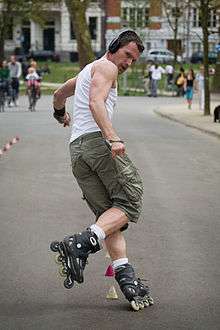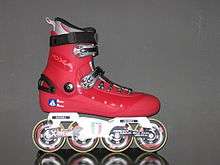Inline skating

Inline skating is a multi-disciplinary sport and can refer to a number of activities practiced using Inline skates. Inline skates typically have two to five polyurethane wheels, arranged in a single line by a metal or plastic frame on the underside of a boot. The in-line design allows for greater speed and maneuverability than traditional (or "quad") roller skates. Following this basic design principle, inline skates can be modified to varying degrees to accommodate niche disciplines.
Inline skating is commonly referred to by the proprietary eponym "rollerblading", or just "blading", due to the popular brand of inline skates, Rollerblade.
History
The modern style of inline skates was developed as a substitute for ice skates, for use by a Russian athlete[who?] training on solid ground for Olympic long track speed skating events[citation needed]. Life magazine published a photo of American skater Eric Heiden, training for the 1980 Olympics, using such skates on a Wisconsin road.
In 1980, a group of ice hockey players in Minneapolis, Minnesota were looking for a way to practice during the summer. Scott and Brennan Olson formed the company Rollerblade, Inc., to sell skates with four polyurethane wheels arranged in a straight line on the bottom of a padded boot.
Disciplines

Aggressive inline
Aggressive skating (referred to by participants as rollerblading, blading, skating or rolling) is a sub discipline primarily focused on the execution of tricks in the action sports cannon. Aggressive inline skates are specially modified to accommodate grinds and the jumping of large gaps. Aggressive skates are identifiable by a prominent gap in between the second and third wheels (known as the H-Block) which allows for grinds perpendicular to the direction of the wheels. A hard plastic surface on the sole of the boot known as a "Sole plate" or "Soul Plate" allows grinds parallel to the direction of the wheels. From these grind surfaces comes a lexicon of well known grind stances, though sliding can occur on any surface of the boot or wheels. Aggressive skates typically have much smaller wheels than a traditional inline skates. The small size allows for more freedom when grinding as there is less risk of catching on obstacles. Additionally these small wheels feature a flat profile to accommodate the impact from jumping tall heights.
Park skating refers to doing tricks within a skatepark, meaning a space that is designed for skating, designed and laid out as such. Street skating specifically refers to tricks performed on non-allocated obstacles (i.e. not skate parks).
Freestyle skating
Freestyle skating is a form of inline skating performed on flat ground and refers collectively to the disciplines for which competitions are organized by the International Freestyle Skaters Association.[2] Currently the IFSA has defined three disciplines which must be offered by any competition they sanction: freestyle slalom, speed slalom, and free jump. Two additional disciplines, high jump and jam, are also defined, but are at present considered optional.
Hockey
Hockey performed in a special rink on inline skates Originally thought up by ice hockey players who wanted to continue training in their off season. Hockey rollerblades have wheel sizes generally in the 70-78mm range. The toe end of the boot is characteristically squared off. The feel of the boot is generally the same as ice skates, so the switch off between hockey skates and hockey is diminished- leading to better in-training simulations of ice hockey.
Off-road skating
Roller soccer
Five-a-side football on skates taking place in an indoor sports hall or outside space with appropriate demarkation
Speed skating
Also known as inline racing, speed skating is the sport of skating (usually on flat surfaces, such as roller-rinks) with the intent to beat the opponent's time score or get to the finish line first.
Vert skating
A term used to refer to inline skates on a vert ramp, a half pipe with some vertical in it usually between 6in to 24in. Vert skating is a form of gymnastics performed with skates. The purpose of vert skating is to ride higher than the coping (which is the metal pipe on top of the ramp) and perform spins or flips. It focuses on complicated hard aerial maneuvers, such as spins and flips. The intent of the skater is to build speed until they are of sufficient height above the edge of the ramp to perform various aerial acrobatics. In competitions skaters have limited time, often less than a minute, to impress the judges by landing numerous and difficult tricks. The sport was included in the first X Games in 1995. Vert skating is used in a lot of competitions such as the X Games. Vert ramps are also present in most skateparks of today.
References
- ↑ GmbH, Grindhouse (9 December 2016). "General information about wheels | Grindhouse Skateshop". www.grindhouse.eu. Retrieved 2016-12-09.
- ↑ "http://www.ifsasports.org/category/sports". Archived from the original on 2010-12-26. Retrieved 2010-10-30. External link in
|title=(help)
External links
| Wikimedia Commons has media related to Inline skating. |
| Look up in-line skating in Wiktionary, the free dictionary. |
- Inline skating at Curlie (based on DMOZ)